When I was growing up, my father had a 6×6 foot garden plot in our tiny backyard in Northeast Philadelphia. The amount of food he coaxed out of it was astonishing – beautiful, red “Big Boy” tomatoes,  zucchini, cherry tomatoes, eggplants, cucumbers, carrots, radishes, onions, lettuce, spinach, and did I mention zucchini? I’m not about to start waxing poetic about working side-by-side with him, smelling the rich loam, getting in touch with nature and such. My childhood memories of gardening are of rubbing my nose, sneezing and swatting the bugs away. Oh, and those huge tomato slugs. Ugh. And being asked to take care of the ever-thirsty plants in the heat of July and August when my parents would go away for long vacations. (“It’s not MY garden!” said in a petulant teenage voice.) Let’s just say I didn’t “get” gardening.
zucchini, cherry tomatoes, eggplants, cucumbers, carrots, radishes, onions, lettuce, spinach, and did I mention zucchini? I’m not about to start waxing poetic about working side-by-side with him, smelling the rich loam, getting in touch with nature and such. My childhood memories of gardening are of rubbing my nose, sneezing and swatting the bugs away. Oh, and those huge tomato slugs. Ugh. And being asked to take care of the ever-thirsty plants in the heat of July and August when my parents would go away for long vacations. (“It’s not MY garden!” said in a petulant teenage voice.) Let’s just say I didn’t “get” gardening.
That started to change a bit when I moved into my first home, a townhouse in a condo community. I started doing some herbs and flowers in pots, which is also a daily watering chore on a sunny summer deck. I became enamored of geraniums. They like sun and can handle neglect. I do neglect very well.
 But when we moved into our home in Wycombe over two years ago I immediately set to work establishing an herb garden. The vegetables I could get from more talented and experienced local farmers at markets and our Community-Supported-Agriculture (CSA) farm. But herbs! I wanted to gather parsley, sage, rosemary and thyme mere steps from my kitchen. One of my proudest gardening moments was Thanksgiving, when my brother (the chef) was visiting and preparing the turkey. He reeled off a bunch of herbs he would need and asked if I could buy them. I smiled, handed him a scissors, and pointed him towards the backyard.
But when we moved into our home in Wycombe over two years ago I immediately set to work establishing an herb garden. The vegetables I could get from more talented and experienced local farmers at markets and our Community-Supported-Agriculture (CSA) farm. But herbs! I wanted to gather parsley, sage, rosemary and thyme mere steps from my kitchen. One of my proudest gardening moments was Thanksgiving, when my brother (the chef) was visiting and preparing the turkey. He reeled off a bunch of herbs he would need and asked if I could buy them. I smiled, handed him a scissors, and pointed him towards the backyard.
When I worked at clearing out my herb garden this year, I was thrilled. As expected, the oregano, thyme, sage and garlic chives had all survived the winter. But the parsley! It’s back in a big way. The workhorse of the herb garden and a staple of so many recipes. Another thrill was the garlic cloves I had planted for the first time last fall. Their shoots are growing an inch a day, it seems, with all this rain and I can’t wait til they begin to curl. Then I’ll have my first garlic scapes – the top part of the garlic bulb, cut down in spring to encourage the garlic below ground to grow into a healthy bulb. Chop it up, sauté it or just throw it in a salad. It makes a brief appearance in late spring, mostly at farm markets.
I’m beginning to “get” gardening. The joy of peering over something you’ve planted and seeing it thrive. Harvesting it and turning it into something you can eat, instead of buy at a supermarket. If you’ve ever considered starting food production in your own backyard, or have made some tentative steps and want to do more organic gardening, then come to the Bucks County Foodshed Alliance’s monthly meeting on Wednesday, May 4th, being held at the Doylestown Mennonite Meetinghouse. The topic, “Bringing Food Production Back Home,” will be led by organic gardening pro Paul Thompson, president of the BucksMont Organic Garden Club. Thompson, a veteran of 35 years of organic vegetable production, will share ideas about creating a backyard food supply and answer questions for experienced as well as novice gardeners. For example:
- Which vegetables are the easiest to grow?
- Which crops will save my household the most money?
- What can I grow that’s tasty, easy, nutritious — and new and different?
- What are the most efficient and productive organic gardening techniques?
- How can I expand my growing space and increase my yields?
“A small garden can reap big returns in taste, nutrition, savings and convenience,” says Thompson. “But the larger issue is ‘food security.’ Growing our own food and buying from local small farms yield dividends to our communities and our ecosystems by helping to preserve our region’s rich agricultural heritage and reduce our dependence on unsustainable petroleum fertilizers and transportation fuels.”
The May event, which is free and open to all, will be held at the Doylestown Mennonite Meetinghouse, North Broad Street and Sandy Ridge Road, Doylestown, 7:30-9:00 pm.
 Another news item about new gardens caught my eye. The Yardley Inn now has its own riverside garden to supply their kitchen and the creative talents of Chef Eben Copple. Chef Eben has long been a supporter of using local produce at the Yardley Inn and he’s thrilled to have a garden of his own, although he admits in an article on phillyburbs.com that it will be a learning experience.
Another news item about new gardens caught my eye. The Yardley Inn now has its own riverside garden to supply their kitchen and the creative talents of Chef Eben Copple. Chef Eben has long been a supporter of using local produce at the Yardley Inn and he’s thrilled to have a garden of his own, although he admits in an article on phillyburbs.com that it will be a learning experience.
‘Our goal is to get four seasons of yield out of the garden, which is going to be a little tricky. We’re going to be learning a lot this year, but the payoff will be incalculable.’
The new garden will grow several varieties of vegetables and herbs including peas, peppers, tomatoes, thyme, squash, eggplant, cucumbers, fava beans, cranberry beans, scallions, beets, radishes, turnips, carrots, arugula, frisee, kale, chard, mustard greens, trevisio, brussels sprouts, melons, gooseberries, rhubarb, cress, mache and much more.
Diners can expect to experience fresh additions from the garden as early as next month.”
If you really want to explore backyard self-sufficiency, stop by the Doylestown Bookshop on Saturday, May 7 from 1:00-3:00 pm for a discussion with author Scott Meyer. He’ll be talking about his new book, City Homesteader: Self-sufficiency on Any Square Footage, a handbook about being resourceful, saving money, reducing consumption, and increasing self-reliance. Meyer is a former editor of Organic Gardening for Rodale. The book covers topics such as: gardening on small and large scales, raising dwarf fruit trees, sprouting grains, smoking meats and fish, grinding grains for flour, making cheese, making wine, cellaring, heating without fossil fuel, harvesting rainwater, and composting.
The Doylestown Bookshop is at 16 S. Main Street in Doylestown.

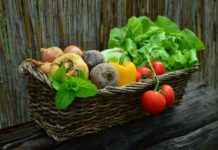


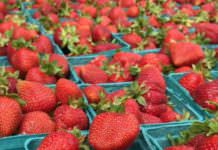
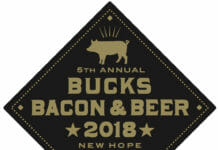
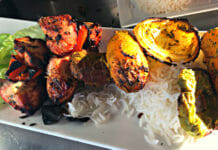

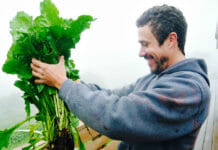
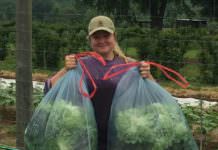
![What we’re reading [Oct 16 2017]](https://www.buckscountytaste.com/wp-content/uploads/2017/10/coffee_macbook_reading_pexels-photo-414630-218x150.jpeg)

Great post, Lynne. Thanks for sharing!
Lisa